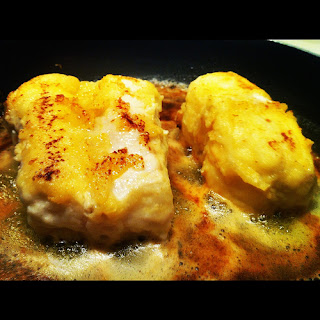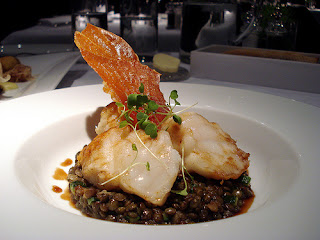Grilled monkfish..
www.flickr.com/photos/stuart_spivack/3253855079/
Lotte, Lotte de Mer, Diable de Mer,
Baudroie - The Angler Fish, Monkfish or Goosefish,
one of the tastiest of all saltwater fish with succulent, very firm, very white
meat. On French restaurant menus, I would place monkfish as number four or five
in the top ten popularity stakes. (Baudroie is the Occitan and Provencal named for
Monkfish and as most of France’s monkfish are caught in the Mediterranean this
is the name on most local menus),
. If you see a whole monkfish in
fishmongers you quickly understand why one of its French names is Diable de
Mer, the devil of the sea; it is an extremely ugly fish. You will also see that there is no meat whatsoever
in its hollow body, and even when a 1 meter (3.3’) fish is caught all the meat is in
the last third, which is its tail. A large fish may weigh 20 kg (44 lbs) of which 12 kg (26 lbs) is the tail.
Facing down a monkfish.
www.flickr.com/photos/slapers/40531567550/
Apart from this fish’s meat, all of which
come from its tail, its cheeks and liver have always been considered a
Provencal and Japanese delicacy; now the monkfish’s cheeks are also growing in
popularity in the rest of France, and they will be on the menu as Joues de
Lotte or Joues de Baudroie.
Monkfish with Ratatouille
www.flickr.com/photos/edsel_/19676933856/
N.B. On some restaurant menus, there may
be another fish called lotte or lote de rivière; this is a freshwater
fish. In English, this fish is the
Burbot, and while it cannot compete with the monkfish it is a meaty fish; by
the lakes and rivers where Burbot are caught in France, they will be on the
menu. The Burbot may look somewhat like a catfish, but it is a freshwater
member of the cod family if the menu is not clear ask.
Monkfish on French menus:
Blanquette de Joues de Lotte, Soufflé de Légumes de Saison et Riz - A stew made with the cheeks of the monkfish served with a soufflé
made with the season’s vegetables and rice.
A blanquette is a stew
originally created for white meats, that is: rabbit, lamb, pork and veal; today
a blanquette will often be seen with fish.
Blanquette recipes usually include mushrooms and white wine in a cream
or crème fraiche sauce. Now that the cheeks of the monkfish have begun to be
enjoyed outside of Provence, they may be on your menu; they taste somewhat
similar to scallops with a different texture. The renewed popularity of
monkfish cheeks in the north of France where they were initially ignored has
sent the prices up. Additionally, the popularity of monkfish cheeks has brought
the cheeks of many other fish into contention. Other menus show that French
chefs are experimenting with cod cheeks, tuna cheeks, and more.
Pan
roasted monkfish.
www.flickr.com/photos/naotakem/3676846367/
Bourride de Baudroie - Provence’s most
popular and famous monkfish stew, often flavored with saffron;
monkfish is the only fish in the bourride de baudroie. The Bourride de Baudroie
is traditionally a large stew a so you may pass on any hors d’ oeuvres or
entrees unless you are really very hungry. The only fish in this stew is the
monkfish; the rest of the stew is vegetables and, of course, plenty of garlic
flavor and aïoli
a garlicky mayonnaise. Depending on the chef, this stew will be accompanied
by potatoes, and usually, additional aïoli or a rouille sauce with garlic toast
will be on the side.
Monkfish in safaron.
Photograph by courtesy of horax zeigt hier
Lotte de Quiberon Rôtie, Risotto Carnaroli aux Cèpes Français Roasted monkfish from the area of Quiberon in Brittany, accompanied by a risotto made with the Italian carnaroli rice and French porcini mushrooms.
When I saw this menu item I wished that I had been able to order it right there and then; all the parts of the offered dish are special, and when offered with a carnaroli rice risotto they become unique. Monkfish are also one of the few fish that really can be roasted and that alone would make this dish special.
The fish and seafood from Bretagne are considered among the very best in France and so their origin will be noted on many menus; however, here the chef is indicating a specific place and for the cognoscenti, Quiberon is a very special source for monkfish. Quiberon is a peninsula on the southern coast of the département of Morbihan and apart from its fishing industry and oyster and mussel farms Quiberon is a very popular summer holiday vacation spot for the French. In July and August do not even think about looking for a free hotel room; the hotels are often booked up to one year in advance. The carnaroli rice used for the risotto is the rice that 99% of all Italian and French chefs will agree is unbeatable where risotto is concerned. The Arborio and Baldo rices may be better known, but carnaroli rice which comes from the same part of Italy as the Arborio and Baldo is even better. Here the risotto is made with those very tasty French porcini mushrooms; what could be better. French porcini mushrooms are equally tasty family members of the better known Italian porcini mushrooms.
The fish and seafood from Bretagne are considered among the very best in France and so their origin will be noted on many menus; however, here the chef is indicating a specific place and for the cognoscenti, Quiberon is a very special source for monkfish. Quiberon is a peninsula on the southern coast of the département of Morbihan and apart from its fishing industry and oyster and mussel farms Quiberon is a very popular summer holiday vacation spot for the French. In July and August do not even think about looking for a free hotel room; the hotels are often booked up to one year in advance. The carnaroli rice used for the risotto is the rice that 99% of all Italian and French chefs will agree is unbeatable where risotto is concerned. The Arborio and Baldo rices may be better known, but carnaroli rice which comes from the same part of Italy as the Arborio and Baldo is even better. Here the risotto is made with those very tasty French porcini mushrooms; what could be better. French porcini mushrooms are equally tasty family members of the better known Italian porcini mushrooms.
Grilled monkfish on lentils,
Photograph by courtesy of Kake.
http://www.flickr.com/photos/kake_pugh/4410146450/
http://www.flickr.com/photos/kake_pugh/4410146450/
Lotte Rôtie, Bouillon de Homard aux Herbes Fraîches, Rattes Safranées et Brunoise de Légumes. A roasted cut of monkfish served in a lobster bouillon accompanied by saffron flavored ratte potatoes and vegetables cut in the brunoise manner.
Ratte potatoes are one of France’s favorite potatoes and their name actually does mean a rat a or a mouse; however, that is nothing to do with their taste. Their name indicates that some can be considered a modern art version of a rat or a mouse when they are as yet uncut and uncooked. Brunoise is one of the ten or more special French cuts used for the shapes and sizes of vegetables and some fruits; a vegetable cut brunoise denotes a cut about 2mm thick.
Smoked Monkfish
Photograph by courtesy of boo_licious
Ragoût de Queue de Lotte aux Légumes de Saison et sa Crème aux Huîtres - A stew of monkfish tail prepared with the season’s vegetables in a cream of oyster sauce.
A whole monkfish.
Photograph by courtesy of alistairas.
Only rarely will you see a whole monkfish in a fish market as there is no meat on the body and its head is quite ugly; apart from its tail, cheeks and liver there is nothing to sell to most customers; the fishmonger will sell the head and body for those who are making fish stock.
Monkfish tails.
The meaty tails mostly weigh over one kilo, (2.2 lbs), and will be sold skinned; the cheeks and liver will both be sold separately and that is often to restaurants. Monkfish livers may, however, may not be on too many menus as their price has risen very year, over the last few years; the demand from Japan has created a very active export market.
(Catalan - rap), (Dutch - hozemond), (German - seeteufel or angelfisch), (Italian - coda di rospo, rana perscatrice or diavolo di mare), (Spanish – lophius or rape).(latin - lophius piscatorius),
Connected Posts:
Ail
- Garlic. Garlic in French Cuisine.
(Catalan - rap), (Dutch - hozemond), (German - seeteufel or angelfisch), (Italian - coda di rospo, rana perscatrice or diavolo di mare), (Spanish – lophius or rape).(latin - lophius piscatorius),
Connected Posts:
Behind the French Menu
by
Bryan G. Newman
behindthefrenchmenu@gmail.com
Copyright 2010, 1013, 2017





















